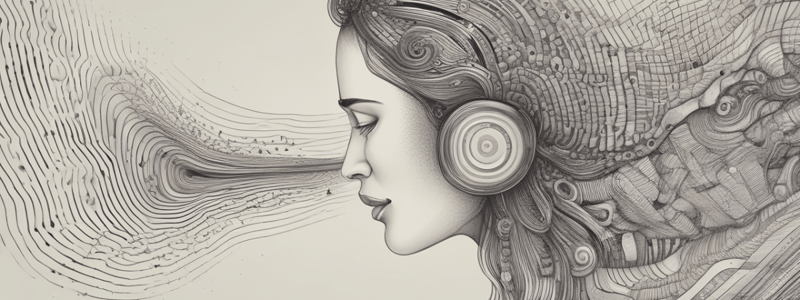Podcast
Questions and Answers
What is the range of sound frequencies that human ears can perceive?
What is the range of sound frequencies that human ears can perceive?
- 20-20,000 hertz (correct)
- 0-5,000 hertz
- 10-15,000 hertz
- 500-25,000 hertz
What is the main function of Fourier analysis in auditory perception?
What is the main function of Fourier analysis in auditory perception?
- To compare amplitude levels of different sounds
- To enhance the frequency of sound waves
- To break down complex tones into pure tones (correct)
- To amplify sound waves for better hearing
Which term refers to the physical quality of sound that describes its loudness?
Which term refers to the physical quality of sound that describes its loudness?
- Frequency
- Amplitude (correct)
- Complexity
- Timbre
What distinguishes pure tones from complex sounds?
What distinguishes pure tones from complex sounds?
What do areas of high pressure and low pressure in sound waves represent?
What do areas of high pressure and low pressure in sound waves represent?
What is the primary function of the deepest layer of the superior colliculus?
What is the primary function of the deepest layer of the superior colliculus?
How is the primary auditory cortex organized?
How is the primary auditory cortex organized?
What characterizes the primary auditory cortex's response to tones?
What characterizes the primary auditory cortex's response to tones?
What are the two streams of the association cortices involved in auditory processing?
What are the two streams of the association cortices involved in auditory processing?
What areas surround the primary auditory cortex?
What areas surround the primary auditory cortex?
What is one of the main differences between the two superior olives and the deepest layer of the superior colliculus?
What is one of the main differences between the two superior olives and the deepest layer of the superior colliculus?
What is the function of the tympanic membrane in the auditory process?
What is the function of the tympanic membrane in the auditory process?
Which part of the ear is responsible for converting sound energy into action potentials?
Which part of the ear is responsible for converting sound energy into action potentials?
How does the basilar membrane differentiate between high and low frequency sounds?
How does the basilar membrane differentiate between high and low frequency sounds?
Which structure helps in the dissipation of excess energy from the travelling wave in the cochlea?
Which structure helps in the dissipation of excess energy from the travelling wave in the cochlea?
What role does the medial superior olive play in sound processing?
What role does the medial superior olive play in sound processing?
What structure in the cochlea contains hair cells with stereocilia?
What structure in the cochlea contains hair cells with stereocilia?
Where does the auditory information travel after leaving the auditory nerve?
Where does the auditory information travel after leaving the auditory nerve?
What happens to the auditory neurons located at the base of the basilar membrane?
What happens to the auditory neurons located at the base of the basilar membrane?
What is the role of the lateral superior olive in sound localization?
What is the role of the lateral superior olive in sound localization?
What aspect of sound waves can the cochlea specifically respond to?
What aspect of sound waves can the cochlea specifically respond to?
Study Notes
Physical and Perceptual Qualities of Sound
- Human hearing range: 20 to 20,000 Hz.
- Sound qualities: amplitude (loudness), frequency (pitch), complexity (timbre).
- Natural sounds are complex due to combinations of pure tones, creating rich tones.
- Fourier analysis enables breakdown of complex tones into pure tones.
The Ear Structure and Function
- Sound involves vibrating air molecules with high and low-pressure areas.
- The ear processes sound vibrations through the auditory canal, tympanic membrane (eardrum), ossicles (malleus, incus, stapes), and cochlea.
- The cochlea contains fluid compartments and membranes, where vibrations are converted to traveling waves.
- Action potentials occur in the cochlea when the wave interacts with specific membranes.
Cochlea and Frequency Coding
- The cochlea has three fluid-filled compartments; the basilar membrane responds to sound frequencies.
- Stereocilia on hair cells in the Organ of Corti bend in response to traveling waves, activating auditory neurons.
- High-frequency sounds activate auditory neurons at the base of the basilar membrane; low-frequency sounds activate neurons at the apex.
Auditory Pathway to the Brain
- Neural pathway: auditory nerve → cochlear nucleus → superior olives → inferior colliculus → medial geniculate nucleus of thalamus → primary auditory cortex.
Sound Localization Mechanisms
- Medial Superior Olive: Detects differences in arrival times of sound at each ear for localization.
- Lateral Superior Olive: Responds to amplitude differences between ears to determine sound location.
- Superior Colliculus: Integrates auditory and visual inputs for locating sound sources in three-dimensional space.
Auditory Cortex
- Located in the temporal lobe within the lateral fissure.
- Primary auditory cortex consists of the core region, organized tonotopically for frequency response.
- Surrounding areas: secondary auditory cortex with the belt and parabelt areas.
- Primary auditory cortex optimally responds to rich and natural tones, less to pure tones.
- Association cortices include two streams: anterior stream (sound identification - "what?") and posterior stream (sound localization - "where?").
Studying That Suits You
Use AI to generate personalized quizzes and flashcards to suit your learning preferences.
Description
Explore the fascinating world of sound and how human ears perceive it. This quiz covers the physical qualities of sound, including amplitude, frequency, and complexity. Dive into the differences between pure and rich tones, as well as the principles of Fourier analysis.




